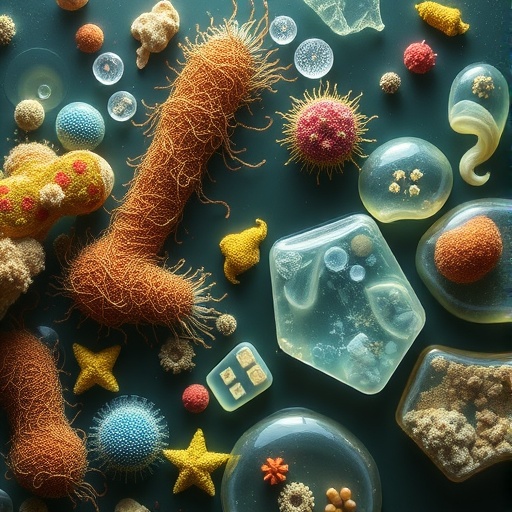In the intricate study of environmental sciences, a recent research publication sheds light on the complex interplay between dissolved organic matter (DOM) and its environmental and microbial influencers. This pioneering work, led by scientists Guo, Liu, and Wang, highlights that a thorough understanding of DOM is crucial, particularly in light of its critical role in ecological health and biogeochemical cycles across diverse ecosystems.
The research reveals that dissolved organic matter, often described as the organic fraction of organic matter that passes through a filter, functions as a vital component of the aquatic systems. It not only serves as a crucial nutrient source for microorganisms but also plays a fundamental role in the global carbon cycle. Consequently, understanding its dynamics becomes imperative for researchers aiming to address pressing environmental challenges, including climate change and ecosystem degradation.
One of the significant findings of the study is how environmental factors, including temperature, pH, and nutrient availability, influence the concentration and composition of DOM in different habitats. These variables create a mosaic of conditions under which various forms of DOM can thrive or decompose. The research indicates that in warmer climates, the breakdown of organic materials increases, leading to higher concentrations of dissolved organic carbon, which can further affect the microbial communities dependent on these changes.
Microbial communities are inherently linked to the turnover of dissolved organic matter. This research identifies specific microbial taxa that significantly contribute to the degradation and transformation of DOM. By unraveling the genetic and functional traits of these microbes, scientists can better predict how variations in environmental conditions might impact the cycling of DOM. Notably, these microbial dynamics play a crucial role in determining the overall health and functioning of ecosystems.
Interestingly, the study takes a multidisciplinary approach, integrating methodologies from environmental science, microbiology, and biochemistry. Such an approach enables researchers to obtain a holistic view of how DOM interacts within ecosystems. By combining field measurements with controlled laboratory experiments, the research establishes a robust framework for further studies aimed at dissecting the complex relationships and feedback mechanisms between DOM, microbial communities, and environmental factors.
Another notable aspect is the role of anthropogenic influences on the production and composition of DOM. Urbanization, agriculture, and industrial activities add layers of complexity to the natural cycling of organic matter. The study emphasizes that increased nutrient runoff, particularly nitrogen and phosphorus, from agricultural practices can lead to significant shifts in the structure and function of DOM. This alteration not only affects the microbial communities but also has broader implications for water quality and ecosystem services.
In examining the geographic variability of DOM across ecosystems, the researchers conducted comparative analyses that illuminate how different habitats, from freshwater lakes to coastal waters, exhibit unique DOM profiles. This variance underscores the need for region-specific management strategies aimed at optimizing DOM dynamics for enhanced ecosystem resilience. Utilizing remote sensing technologies alongside in-situ measurements, the study marks a significant stride toward understanding these variations on a global scale.
The implications of the research extend to climate change, as altered dissolved organic matter dynamics are expected to feedback into larger carbon cycling processes. The potential for increased carbon release due to warming temperatures and changing precipitation patterns poses challenges for predicting future ecosystem responses. Understanding DOM as both a carbon source and sink reinforces its significance in climate models and underscores the necessity of including biological factors in climate action strategies.
Moreover, the study encourages the academic community to adopt a more synergistic approach to research that bridges gaps between disciplines. By fostering collaborations among environmental scientists, ecologists, and microbiologists, there is a greater potential to unveil the intricacies involved in DOM dynamics. Interdisciplinary initiatives could offer innovative solutions to mitigate the adverse impacts of human activities on natural ecosystems.
As the researchers share their findings, they hope to catalyze further exploration and discussion within the scientific community. The intricacies of dissolved organic matter are still far from being fully understood, and ongoing research is critical for informing better management practices and conservation strategies. Continuous data collection and integration of novel technologies, such as artificial intelligence, can enhance predictive capabilities regarding how DOM will respond to global changes.
In conclusion, Guo, Liu, and Wang’s extensive research not only enriches our understanding of dissolved organic matter and its interplay with environmental and microbial factors but also serves as a call to action for integrated and innovative research. As the scientific community continues to grapple with the consequences of environmental change, understanding the role of DOM becomes an essential piece of the puzzle in preserving the planet’s ecological integrity.
This study is a testament to the collaboration between various fields of research, reminding us that the complexities of nature often require multifaceted solutions. The interactions between dissolved organic matter and the myriad of factors influencing its dynamics are indeed profound, and as we delve deeper into these relationships, we open avenues for sustainable management practices that can lead to healthier ecosystems for future generations.
Subject of Research: The influence of environmental and microbial factors on dissolved organic matter across various ecosystems.
Article Title: Environmental and microbial factors shape dissolved organic matter across multiple ecosystems.
Article References: Guo, B., Liu, Y., Wang, J. et al. Environmental and microbial factors shape dissolved organic matter across multiple ecosystems. Commun Earth Environ 6, 917 (2025). https://doi.org/10.1038/s43247-025-02848-3
Image Credits: AI Generated
DOI: https://doi.org/10.1038/s43247-025-02848-3
Keywords: Dissolved organic matter, microbial communities, environmental factors, ecosystems, climate change, nutrient cycling, ecological health.




